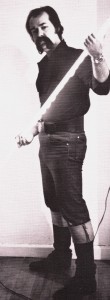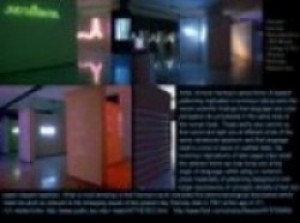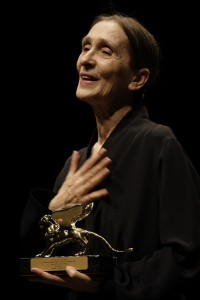Born on July 26, 1944: Mick Jagger, Annson Kenney and Joseph Franklin
© Merilyn Jackson

Photo by: Merilyn Jackson
Annson Kenney at a party six months before his death.
I don’t know where Jagger was born. I only saw Mick once in person, after a concert at the Spectrum. He was pacing up and down the sidewalk at a restaurant across the street from my Front Street house in Queen Village. In typical Philly fashion I threw up my window sash, stuck my head out and yelled “Yo Mick, how ya doin?” Startled, he stopped searched for my voice, gave me a wave and said “Quite all right, thank you.” I responded with something like “Glad to hear” and respecting his privacy, I lowered the window and left him to his to and fro.
I did know the late Annson Kenney and do know the very live and quick Joseph Franklin who were both born in the same Philadelphia hospital on the same day as Jagger. As I recall, the two did not meet until they were in their 20s and burning to make a mark on the city’s arts scene, Annson with his music, performance art, writing and neon works and Joe with his New Music. The two met through a mutual friend in the 70s who later also introduced them to Arthur Sabatini. (I would shortly meet and run off to live with Sabatini and still do.)
A quick friendship formed between the three men. Over the next few years Kenney and Franklin, along with Joseph Showalter, formed Relâche, the Ensemble for Contemporary Music, now known simply as The Relâche Ensemble. At first Sabatini was an ad-hoc advisor; later he wrote much of the copy for the programs and the New Music America Festival in 1987. By that time I was the Relâche publicist.
I’d cook for us all as the guys held meetings, interviewed musicians and planned concert programs. Many nights we sat in the living room overlooking the Delaware River, eating, arguing and laughing in front of that window through which I’d later greet Mick. We called it Café 752.
It was in the late 1970s that Relâche first introduced such contemporary musical giants as Terry Riley, Philip Glass, Steve Reich, Gavin Bryars and John Cage, along with a host of other composers, to Philadelphia audiences. Make that, SMALL audiences. Philly wasn’t so hip and smart in those days to take these musics in their stride, let alone with enthusiasm. Save for a small but growing coterie, few so-called music-lovers liked what Relâche was serving.
Meanwhile Kenney had a late night radio program on WHYY called NOIZE, taught at Philadelphia College of Art (now University of the Arts) wrote on a variety of subjects for Philadelphia Magazine, Metropolitan Magazine, Foxylady and The Philadelphia Inquirer. He wrote columns under the pseudonym Blackie Carbon for long defunct alternative paper, The Drummer and a restaurant review column called Oral Gratification for the Daily Planet. He composed music (performed solo and by Relâche) and created astonishing videos and performance art he called stunts. Simultaneously, he was showing his neon art at galleries like Marian Locks, The Painted Bride (where Sabatini and I met after he read his poetry) and his last show, Variations on Three Bauhaus Bends at The Pennsylvania Academy of the Fine Arts.

“Eternity is a long, long gig.” Annson installing a show at the Art Alliance
On New Year’s Eve Eve, 1981, Annson and Buster Thompson, a racing car mechanic from the UK (working on Roger Daltry’s cars for one) began bar-hopping. Sabatini and another friend, David Erlich, had planned to meet up with them at one of the places they usually hung out back then: Lickety Split, Sassafras, Purgatory, The East Side Club. But everywhere they went they were told Annson and Buster had just left. Someone had stolen Annson’s custom racing jacket off his barstool at Lickety and they were searching for it, partying the night away as a matter of course. Well after the after hours clubs closed and not wanting to troll the after after hours joints, Arthur and David gave up their chase.
About 1 p.m. the next day, the phone rang. Arthur answered, talked for a few minutes and came up to our attic office white-faced – and not just from his hangover. I stared at him from behind my desk and said “Annson?” He nodded. I said “Dead?” He nodded again, this time nearly crumpling. I said “Gun?” He shook his head no. I said “Car?” He said “Yes.”
Later, we learned that about 5:30 that morning, according to Buster, the tires on his Ford Fiesta got stuck on trolley tracks up in Germantown where they had just dropped off a couple of guys. The trolley stopped in front of them and Buster says he could not brake in time. The Fiesta’s hood smashed under the trolley’s “cow catcher.” Annson was not wearing a seatbelt and the dashboard crushed his chest. He did not die instantly. He was still alive while the firemen used the jaws of life to free him. It took an hour. He was pronounced dead at the hospital. Only 37 years old with what he had started ending in the middle.
That night, Arthur and I were having our usual New Year’s Eve party, where Annson had been expected. I had already prepared a lot of food and bought two Peking ducks from around the corner. Within hours we had called a number of people to let them know and invite them to what was then a wake. Annson’s Irish mother, Ann, and his sister Charlene came. We had ordered two more ducks and more than 40 people (some strangers who had just heard) came laden with food and drink. We asked for donations for the funeral and one jerk asked if it was a rent party.
Nicholas Boonin, a close friend and the one person Annson entrusted to install his gallery shows, was there. Joanne Hoffman steamed us a salmon which I swear was salted in tears. Julius Scissor (Frankie Pinto) talked about Annson dancing The Worm and when Annson’s mother asked what that was, Julius got down on the floor and shimmied.
At midnight the fireworks went off at the Benjamin Franklin Bridge and some went outside to watch while the rest crowded around our three windows. When they were over, Nicholas threw his glass out on the pavement, cursing. Joanne chided him. She knew I had just bought 10 new champagne flutes for the celebration. But I said “It’s only a fucking glass,” and threw mine out the window as well. Nicholas looked at me in quizzical amusement.
In the morning, as I washed the glasses, I found I still had nine, not eight of those good Rumanian-made flutes. I called Nicholas. “No,” he said. “I didn’t throw a glass. I threw the champagne bottle. But when you threw yours, I thought it was the most gracious gesture of commiseration and hostessing, so I didn’t say anything.”
I ran to the window, the very same I had yelled out to Mick Jagger, threw it open and looked out. Sure, there were the remains of green glass scattered and my glass about he pavement.
This year is the 32nd anniversary of Annson’s death. To the asshole who stole Annson’s jacket, you will never be forgiven for setting off this terrible trail of events.
Annson was brilliant and funny and aggressive. And thoroughly Philly. He titled one of his neon exhibitions, Loose Language. “As an artist I am ethically sworn to make the move which spawns the memory.” That he did.
Happy Birthday and rest in peace, Annson. Happy Birthday and many more years to come, Joseph. And Yo, same to you too, Mick.
For photos of the 54 piece retrospective neon exhibit of Kenney’s work that took place at Moore College of Art in Philadelphia from October 21-November 13,1983, see the link to Nicholas Boonin’s website in the links column.

A Catalogue with biographical material, photographs (many by Joseph Czarnecki) and writings by Annson Kenney available upon request (limited supply in stock).
Price: $ 25.00 includes shipping.



